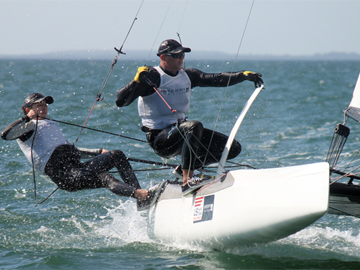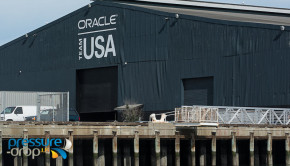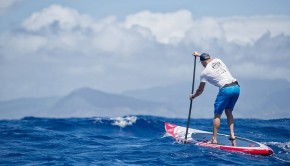Beginning of the new Olympic quad
Published on January 31st, 2013
For most of the North Ameican sailors with Olympic aspirations, the ISAF Sailing World Cup Miami (Jan 28-Feb 2) is the first event of their new quadrennium. Prior to the event, Scuttlebutt publisher Craig Leweck met with the leadership of the US and Canadian sailing teams to to learn what lies ahead.
Feeling good right now
When two-time Olympic medalist Charlie McKee (Coronado, CA) was appointed High Performance Director of the U.S. Olympic Sailing Program, it was a significant hire that followed the team’s medal-less performance at the 2012 Games.
Beyond Charlie’s personal knowledge having sailed in the classes, his enthusiasm and attentive eye translates to effective communication and learning. He is a motivator, but he will make this quad fun too. Here are his hopes for the ISAF Sailing World Cup Miami:
 Primary among our goals right now is to understand the sailors, what it is that they want to achieve, and start off on a track where we can do that together. We need to determine what the team can do to be most helpful for them. Also, we are seeking to foster a cooperative effort within each class as much as possible and recognize that different classes have different needs and that there is no one right way to do things.
Primary among our goals right now is to understand the sailors, what it is that they want to achieve, and start off on a track where we can do that together. We need to determine what the team can do to be most helpful for them. Also, we are seeking to foster a cooperative effort within each class as much as possible and recognize that different classes have different needs and that there is no one right way to do things.
We strongly believe is that it is no one thing that you need to do to succeed; it’s fifty tiny things to get a little better.
While we are called the US Sailing Team Sperry Top-Sider, this remains an individual sport. Everyone’s campaign is going to be different depending on where they are in life, whether they are in school, etc. We need to identify each person’s specific goals and needs and embrace the individuality within each campaign. This puts people in a positive state of mind knowing that there is a systematic approach to insure they can take steps toward improvement.
There is a lot positive energy right now. There has been a lot of good work done from the previous quad, and I am seeing a lot of enthusiasm and confidence that we are on the right track for this next quad. I am sure we are going to make some mistakes, and there are a lot of long term ideas and complicated questions where there is no one solution or easy answers. But where we are and what we are doing right now feels good.
Professionalizing the program
Since the 2012 Olympics, the US Sailing Team Sperry Top-Sider has undergone several structural changes. Chief among them was the appointment of Josh Adams as Managing Director of U.S. Olympic Sailing. The creation of this full-time position continues an effort to professionalize the program and improve the ability to evolve as an Olympic team. Here Josh reveals the team’s plans and ideals.
 What are some of the changes that are occurring?
What are some of the changes that are occurring?
We have a set of vision principles for the organization that is going to impact what we do throughout the quad, and we are starting to reveal how these will be affecting the first year in 2013. The top three of these vision principles are creating a culture of technical excellence, achieving sustainable performance, and building the base of sailors.
What that translates into for 2013 is surrounding our sailors with as much technical expertise and world class coaching as we can. And we have done that by bringing in Charlie McKee, 2-time Olympic medalist, to be our High Performance Director. He is an expert in half the classes and brings this great knowledge, expertise, energy, and enthusiasm to Olympic sailing. Joining Charlie is our new Technical Director, Grant “Fuzz” Spanhake. We are bringing Fuzz onboard to establish baselines standards for tuning and sail trim across all ten Olympic classes and three Paralympic classes. Then we have a great team of class coaches as well.
Among our priorities is developing class by class strategies for success. Charlie is laser focused on this to work with each class to develop their strategy, and the sailors are fully empowered to help develop this strategy. They have a big voice in this along with the coaches. One of the priorities in Miami is to finalize the class strategies for 2013.
Additionally, we need to capture knowledge in each class and keep it, which will enable our strategy of sustainable performance to be successful. Fuzz will be key to this. He worked as Technical Director for the British team over the past 8 years and now he will be working with the U.S. If we grow the knowledge, we are better prepared to support the new, young star when he decides to initiate his Olympic campaign.
An initiative led by Charlie is for all the classes to be working in a collaborative effort. All the American sailors are welcome to the debriefs for each class, and the idea is to help to build the base of our classes. Another change here in Miami is a partnership with Jaguar Therapeutics, which is led by trainer Chris Herrera who has been working with the team for several years. Chris has opened a facility in Coconut Grove which US Olympic and Paralympic sailors have full access to, and the venue will be used for many of the team’s fitness programs.
In part because most Olympic classes are not popular in the U.S., sailors must spend significant time in Europe. What is being done to manage the cost and time of this situation?
The schedule has been re-tooled in the view that we want domestic training to be a strength. So the change is that we are going to train more in U.S. We are still going to be travelling to international competition because you still need that check-in to see where each sailors ranks on the international level. It will always remain important to train with and race against foreign competition. But whenever we can, we will focus our training time in the U.S. to develop performance advances. This is an initiative that both the team and the sailors believe in. These will include a combination of training camps and North American events.
There is a view within the U.S. that the current talent pool will not be ready for the 2016 Games.
I disagree with that assessment. Talent is not our problem in the U.S. for Olympic sailing. We have a lot of sailing talent, and we will be going to the 2016 Olympic Games with a lot of talented athletes. Right now we have an interesting balance of returning veterans who have proven they can win at the Olympic\level and also we have some young talent that we forecast will be emerging stars. You have to look at talent two ways: what is the team that you are putting together in this quad and what are we developing for the future. A big part of our program right now is looking long. We have to look long – it’s a priority. If we do a good job of getting more sailors in high performance boats at a young age, we are going to be able to consistently crank out Olympic sailing talent.
What advice would you give a young sailor with Olympic aspirations?
What we are telling youth sailors now is that there is no one Olympic pathway. There are multiple ways to get into the Game and multiple ways to make it to the podium, and we want to encourage different pathways. The second thing we are telling youth sailors is to spend more time in and gain more experience in high performance dinghies that are feeder classes to Olympic classes. An example would be the International 420 for the 470, the 29er for the 49er, the Techno board for the RS:X, etc. Boats with bendy rigs, boats that plane upwind, boats with sophisticated rig tune and sail trim. This is the kind of experience that youth sailors would benefit from.
They should also be working within the existing framework of events and clinics. This is a priority. The team is working with the U.S. Youth Championship event, and we are working with the prominent youth clinics (CISA, Brooke Gonzalez, etc.) to share our expertise with those clinic organizers and to work with the young sailors at those events. We recognize that there are sailing institutions in this country that are successful for a reason, and we are not interested in changing what they do. We are eager to work with them to help develop sailors.
A prime example is college sailing. We view college sailing as part of the solution. We don’t view college sailing as a problem. We have been spending a lot of time over the past couple months communicating with a lot of leaders and coaches in that community, making sure that the top sailors who are interested in the Olympics or are already on the Olympic path are getting into high performance boats when the college schedule allows for it. And the coaches know this. They know their sailors are in college to further their education, but many of them also have a parallel goal of pursuing an Olympic medal, and that we will need to work together to ensure that all the needs are fulfilled.
Not willing to get skunked again
The U.S. wasn’t the only country to come away from the 2012 Games without any hardware. The Canadian Sailing Team had legitimate medal contenders, but it ultimately wasn’t their national anthem playing at the award ceremony.
Ken Dool, who is the Canadian Sailing Team Head Coach and Director of High Performance, has now coached at six Games, and is eager to make changes to ensure that ‘O Canada’ will be heard at the 2016 Olympics. Ken comments on what lies ahead:
 New approach
New approach
The review of our program recognized that we were trying to do a lot of things without enough resources, both human and financial, and therefore not doing anything very well. So we decided to narrow our focus on the classes that we are working with to insure that we are truly running a coach-driven program, providing true leadership for the program, and not just chasing athletes around the world. We also plan to be more selective in which international events we attend, and to prepare and participate in those events as a team. We must become more ready for each event as a group rather than just hopping along the circuit taking in lots of events.
As for the classes, our Olympic focus for the men will be the singlehanded Laser and Finn and the doublehanded 49er skiff, and for the women will be the singlehanded Laser Radial and doublehanded 49er FX. For the Paralympics, our focus will be the singlehanded 2.4mR. This doesn’t mean we are not interested in other classes, but these are the classes where we will make the investment in leadership and where we will cultivate the training groups, while we will manage the activities in the other classes.
We have very strong athletes competing in the other classes but much less depth. We won’t be disenfranchising these athletes; we simply are not going to invest significant resources to build depth where it currently is not.
But it is not just the depth of the classes we have selected to focus on, but we also feel we can have the broadest effect throughout the program by focusing on these classes. The Laser and Radial in particular are the stepping stones throughout all our provincial programs, so there is an infrastructure that is already in place. Plus we need to do a far better job in the doublehanded events and we identified the skiff as our chance to do that given what is already occurring at the provincial level.
Doublehanded dilemma
When you review the doublehanded classes for both the US and Canada, the quality at the top is not deep, which historically meant the sailors had to go on the World Cup circuit, spend a lot of money to take the hard knocks. We just do not have the depth for quality events in North America that would enable our athletes to develop.
The American system has the benefit of the collegiate program, but again it is a huge transition from a Club Flying Junior or Club 420 to sailing an Olympic class boat. Canada has also had the impact of the Club 420, which has been very good from a learning perspective but it is still a significant transition from that platform to the Olympic level.
Youth development
One of the initiatives that Canada is pursuing is to invest resources to youth development and the youth world competitions. We must insure that proper programming is in place, and not just assume that these young athletes will come to the national level ready to go. We will seek to partner with our provinces and clubs to improve on what we have done historically.
Statistics show that the people who are winning medals at the Olympics, possibly half, have won medals at international youth events, and somewhere around three-fourths of the Olympians competed at international youth events. So there is clearly a correlation between success at the Olympic level and the ability to prepare youth sailors for their international competitions.
Our ultimate goal is for our sailors to be immediately competitive in their first Games and to be legitimate medal contenders in their second games, and we want to see the age of athletes competing in their second games to be lower.
Geographic hurdles
Canada is a big country which creates a challenge in bringing together our athletes. We have identified three centers: Vancouver/Victoria, Halifax, and Toronto. These are attached to Canadian sport centers where they have all the ancillary training and medical services. These won’t be our only training centers, but we hope to emphasize these three centers as we strive to push team members together.
On the road back to the podium
Steve Mitchell has competed and coached at the Olympic level, and has World title trophies on his shelf to show that he knows how to play the game. As the Canadian Sailing Team High Performance Coach/Manager, it wasn’t much fun to see Canada kept off the podium at the 2012 Games, and he is eager to avoid it occurring again in four years at the Brazil Olympics. Here he shares his thoughts on the topic:
 Energizing North America
Energizing North America
Our plan is to focus a lot more on North American based training, group training within the specific classes and some of that is linked to the coordination with the American team. Both countries are competing against each other but we can share resources to make it beneficial for each.
There are also regatta opportunities within the continent that Canada can support and benefit from. Following Miami, there is now an event in Ft. Lauderdale which is open to all the Olympic classes, and a long time Olympic event in Long Beach, CA has been moved on the calendar to better fit into the schedule.
In Kingston, CORK was historically a big event ten years ago but has gradually seen less participants, particularly from outside the country. But now our national team is committed to include CORK on our schedule, which we anticipate will help to attract the American teams as well. We anticipate this will help it become exceedingly useful for both countries, not just for the national teams but for youth development as well.
Balancing depth
With the work within the provincial based system, a lot of our focus is on singlehanded sailing for the shear economies of it. As a result, as the sailors advance to the national team, we see they are better developed singlehanded sailors than doublehanded sailors. So part of our mission is to continue producing good singlehanded sailors but also identify those sailors that might be able to help us in some of the other events. Where we are deepest, we recognize that they all can’t go to the Olympics, so this is in the interest of both the sailor and the team. However, the bottom line is that right now we need to stick to our strengths – singlehanded dinghies and skiffs – for the best use of our limited resources.
Working together
It is vital that we succeed in creating an atmosphere for group-based training. Rather than people running their individual programs within a class, we are encouraging athletes to be in the same place at the same time. This is our ideal, and it may not happen all the time. The reality is that you have a group of people competing against each other, and there will be times when people are not seeing eye to eye. But working together is part of being a team, and if we can instill the team spirit within the group, everyone will push each other harder and will benefit from it.
College years
During the college years, what tends to be happening is that the sailors are going to school in the areas where most of training for their event is happening. This allows them to better balance their studies and amidst the group training. This is far more ideal than the sailor who chooses a school that is not near the bulk of sailors in their event.









 We’ll keep your information safe.
We’ll keep your information safe.